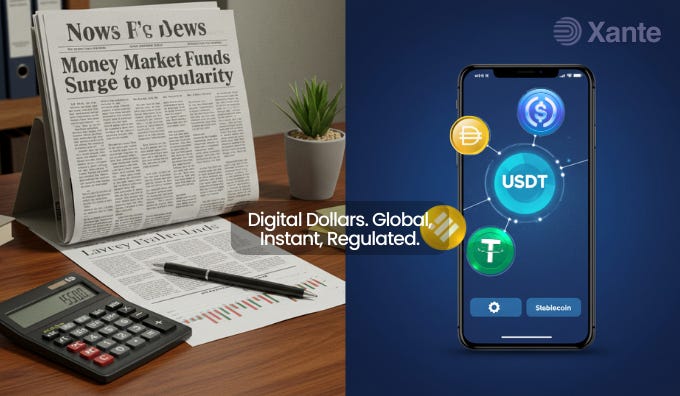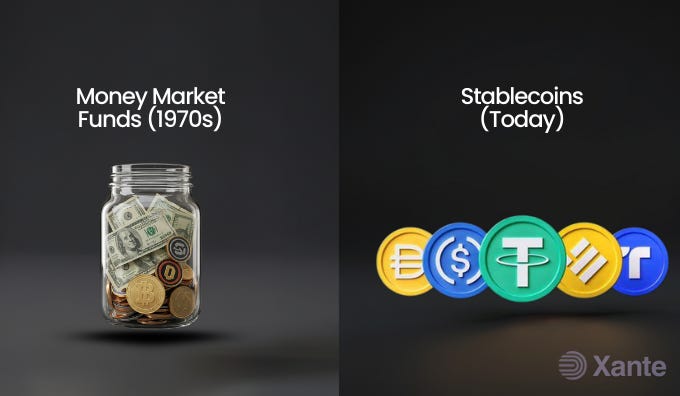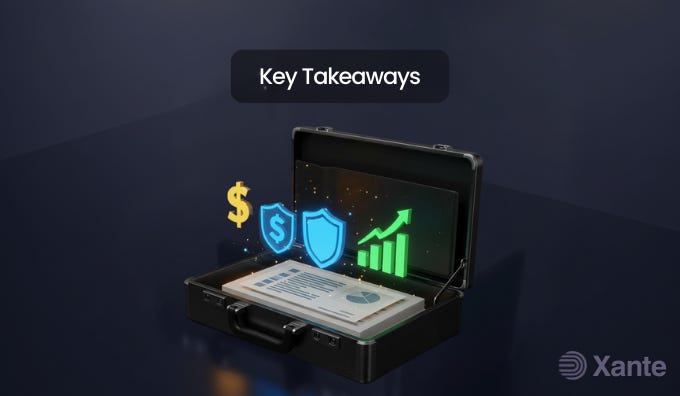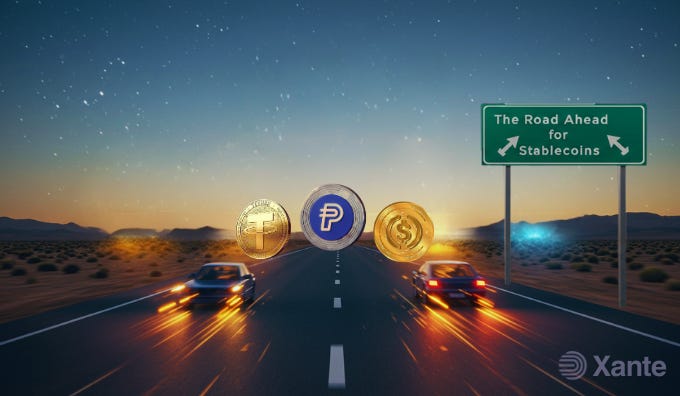Stablecoins, Money Markets, and the Future of Digital Dollars: What the Coming U.S. Regulation Means for Crypto’s Next Big Shift
Explore how stablecoins mirror money market funds from the 1970s and why U.S. legislation could unlock a trillion-dollar opportunity for Web3. Learn the history, risks, and what it means for the future of crypto finance.
Are Stablecoins the Money Market Funds of the 21st Century?
What if I told you the most powerful transformation in digital finance isn’t another meme coin or L2 solution but stablecoins? And not just for DeFi but for reshaping how cash itself flows across the global economy?
In today’s post, we unpack why the upcoming U.S. stablecoin regulation may be the most defining moment in modern financial innovation, drawing striking parallels with the rise of money market funds (MMFs) back in the 1970s.
By understanding history, we can see the future more clearly.
Let’s get into it.
The Rise of Money Market Funds: A Flashback That Feels Familiar
To understand stablecoins’ potential, we need to look back, specifically to the 1970s.
Back then, U.S. banks were banned from paying interest on checking accounts, leaving corporations with limited options for managing excess cash. The solution? A new financial vehicle known as the money market fund, launched in 1971 by Reserve Fund Inc.
“A mutual fund designed as a convenient alternative to the direct investment of temporary cash balances.” – Reserve Fund Prospectus, 1971
Key features of MMFs that mirror stablecoins today:
• Pegged to a stable $1 per share value
• Offered non-bank entities an alternative way to store and move cash
• Circumvented traditional banking regulations
• Offered yield without deposit insurance
By the 1980s, firms like Vanguard, Fidelity, and Dreyfus had entered the space. Today, MMFs collectively manage over $7.2 trillion in assets, according to CoinGecko.
Sound familiar? That’s because stablecoins are walking the same path with the same resistance.
The Stablecoin-Money Market Parallel: Then and Now
Just like MMFs, stablecoins are being scrutinized for:
1. Systemic Risk to the Banking Sector
• Concern: Stablecoins don’t have FDIC insurance or a central bank backstop.
• Historical Echo: Paul Volcker—Fed Chair from 1979 to 1987 criticized MMFs for the same reason, fearing they could trigger mass withdrawals during crises.
Example: In 2008, MMF redemptions nearly collapsed the system after Lehman Brothers’ bankruptcy. In 2022, the TerraUSD collapse did the same for stablecoins, causing over $60 billion in market cap to vanish.
2. Regulatory Arbitrage
• Concern: Stablecoins offer bank-like services without bank-level regulations.
• Parallel: MMFs operated outside of banking charters, yet performed banking functions like maturity transformation and capital preservation.
“You’re acting like a bank. Why don’t you follow the rules of a bank?” Common criticism aimed at both MMFs and stablecoin issuers.
3. Undermining Monetary Policy
• Stablecoins (like MMFs) reduce the effectiveness of Federal Reserve tools, such as interest rate controls and reserve requirements.
• As more money flows out of traditional banks into digital assets, the Fed’s reach diminishes.
Why This Matters Now: A Once-in-a-Generation Legislative Moment
The U.S. is on the cusp of introducing federal stablecoin legislation, creating standards for reserve quality, audits, and issuer structure.
This is monumental because:
• It would legitimize fiat-backed stablecoins for everyday business use.
• Institutions could finally allocate cash into digital formats with clarity.
• It paves the way for tokenized Treasury markets, programmable payroll, and on-chain invoices.
“Stablecoin legislation is a once-in-a-generation chance to upgrade the financial system.” – @shawnwlim, Artichoke Capital
Real-World Applications of Stablecoins Right Now
• PayPal USD (PYUSD) allows instant crypto-fiat conversions for ecommerce.
• Circle’s USDC is integrated into Apple Pay and Shopify.
• Tether (USDT) is enabling cross-border payments in developing nations with limited access to banking.
• Visa is testing stablecoin settlements over Ethereum for faster global payouts.
These are not just ideas, they’re already happening.
Key Takeaways
• Stablecoins are digital equivalents of money market funds, offering yield-bearing, stable-value alternatives to cash.
• The criticisms are old news. the same ones were made about MMFs in the 70s.
• Stablecoin regulation could unlock trillions in new capital inflow into Web3 and digital assets.
• Real-world use cases already exist from instant payroll to global remittances.
• Investors, developers, and regulators must learn from history to shape stablecoins’ future responsibly.
Future Outlook: What’s Coming Next?
• Legislation in the U.S. could create the world’s first regulated, interoperable stablecoin market.
• Major financial players (Visa, PayPal, JPMorgan) are already building in this space.
• If MMFs are any indicator, we could see $10T+ in stablecoin market cap by the early 2030s.
Expect innovations like:
• Tokenized T-bills
• Programmable government disbursements
• Stablecoin credit cards & payroll systems
Actionable Suggestions
If you’re a:
• Web3 builder: Start integrating USDC or PYUSD into your product stack.
• Retail user: Consider stablecoins for cross-border transfers or yield farming.
• Investor: Watch legislation updates, this may shape the next blue-chip digital asset category.
• Policy advocate: Push for smart, balanced regulation that fosters innovation without repeating past mistakes.
Conclusion: The Past Is Prologue
Stablecoins aren’t just crypto tools, they’re financial infrastructure in the making.
If the U.S. gets stablecoin regulation right, it could mark the most important upgrade to the financial system since the invention of money market funds. The world is watching.
Don’t miss next week’s issue. Stay ahead informed!
For daily updates, follow us on all socials; Instagram, Twitter, Telegram, and TikTok. Subscribe to our newsletter for expert analysis to get weekly crypto insights, trend breakdowns, and smart investment takes delivered straight to your inbox and join our WhatsApp channel to continue the conversation.
“The future of money isn’t just digital, it’s programmable, permissionless, and global.”
Let’s build it together.
This article is for educational purposes only and should not be considered financial advice. Always conduct your own research (DYOR) before making any investment decisions.
Sources: CoinGecko, Shawn Lim @ Artichoke Capital, U.S. Federal Reserve, Visa, PayPal, Circle, Fidelity, Vanguard, Bloomberg, Investopedia.





